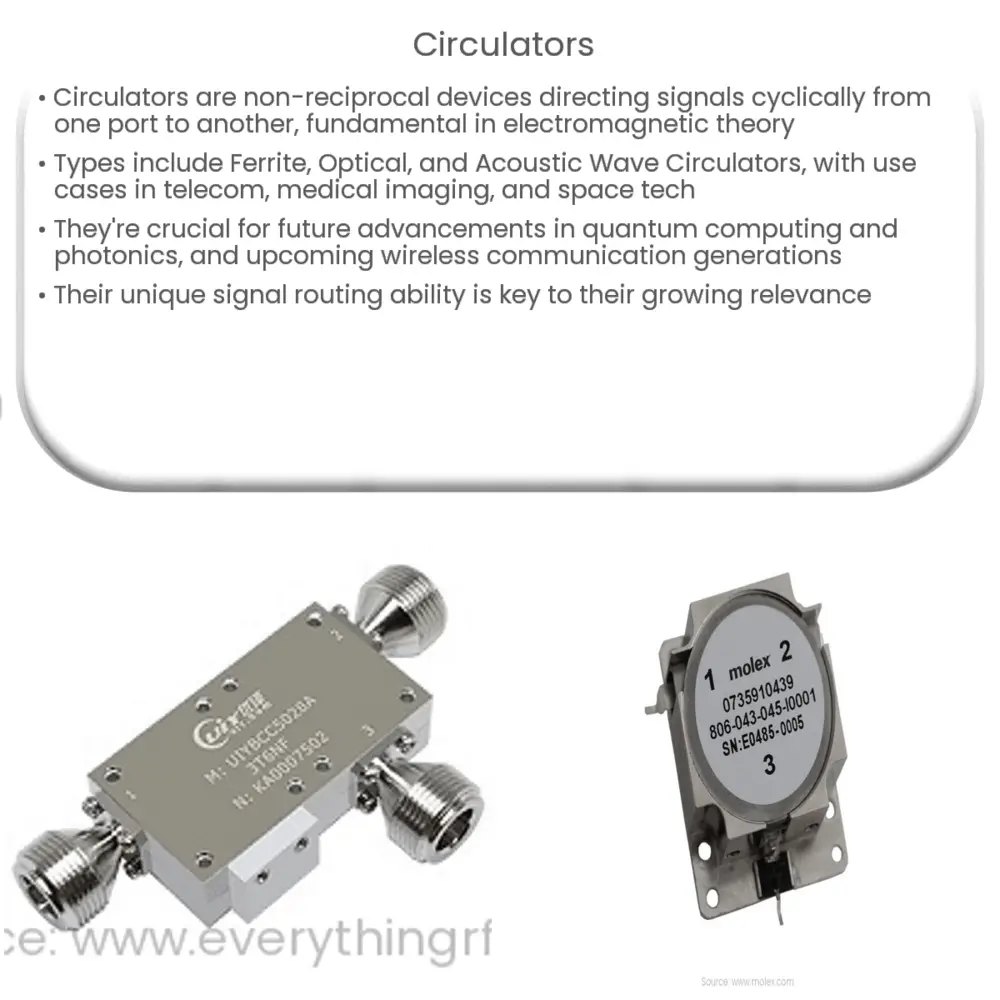Explore the world of electromagnetic circulators, their types, operational mechanisms, diverse applications, and future potential.

Understanding Circulators in the Realm of Electromagnetic Theory
A circulator is a non-reciprocal multiport device that routes electromagnetic (or any wave) signals from one port to the next, in a cyclic manner. For example, in a three-port circulator, a signal entering port 1 would exit from port 2, enter port 2 to exit from port 3, and so on. Let’s delve into its specifics, functioning, and applications.
The Fundamentals of Circulators
Circulators function based on the principles of electromagnetic theory, with the key idea being non-reciprocity. Non-reciprocity refers to the characteristic of a device that allows signals to follow a specified path and direction, while barring them from going in the reverse path.
Types of Circulators
- Ferrite Circulators: These are the most common type, often found in microwave devices. They utilize ferrite materials, and their operation is based on the phenomenon of Faraday Rotation.
- Optical Circulators: These are used in fiber optic communication systems. They function on the principles of magneto-optics and make use of rare earth materials.
- Acoustic Wave Circulators: These are used for steering sound waves and employ piezoelectric materials in their construction.
Operational Mechanism of Circulators
The functioning of a circulator is governed by the properties of the material it’s made from, and the physical principles it relies on. For instance, a ferrite circulator operates by manipulating the magnetic properties of ferrite compounds under the influence of an external magnetic field, resulting in the non-reciprocal propagation of signals.
Applications of Circulators
- Isolation of Devices: Circulators are used to isolate devices from each other in a multi-device setup. They prevent signals from getting back to the source, thereby protecting sensitive equipment.
- Duplexers in Communication: They are extensively used as duplexers in radar and communication systems. Here, the circulator enables the use of a single antenna for both transmission and reception, thereby economizing the system.
In summary, circulators, through their unique non-reciprocal nature, have made a significant impact in areas where the controlled routing of signals is of paramount importance. The discussion to follow will dive deeper into the usage scenarios and the future potential of these devices.
Further Exploration of Circulator Applications
Continuing our exploration of circulator applications, we’ll highlight a few more notable use cases. These examples will illustrate the versatility of circulators and their essential role in many technology sectors.
- Telecommunications: In telecom, circulators are utilized in echo cancellation and signal routing. By ensuring signals are routed correctly, circulators significantly improve signal clarity and reduce errors.
- Medical and Scientific Imaging: In the medical field, circulators are used in imaging devices such as MRIs and advanced X-ray machines. They ensure that signals are properly guided, thus enhancing image clarity and accuracy.
- Space and Satellite Communications: In space technology, circulators are integral to satellite communications. They assist in maintaining clear communication channels, preventing potential signal interference from other satellite systems.
The Future of Circulators
The future of circulators is promising, particularly in the realm of quantum computing and photonics. In these fields, optical circulators that control light signals are key to advancing these technologies. For instance, optical circulators can effectively route single photons, a crucial requirement in quantum computing and communications.
With the advent of 5G and subsequent generations of wireless communication, the role of circulators is set to grow even more important. They will be essential for managing the increased frequency range and for handling multiple inputs and outputs efficiently.
Conclusion
To conclude, circulators are a fundamental component in a variety of fields, from telecommunications to medical imaging, and from space technology to the burgeoning realm of quantum computing. Their unique ability to route signals non-reciprocally, isolating devices from potential feedback and interference, makes them a versatile and essential component in these sectors. As technological advancements continue to push boundaries, the role of circulators is likely to become even more prominent, making it an exciting area to watch in the years to come.

